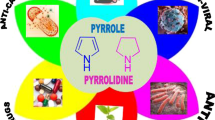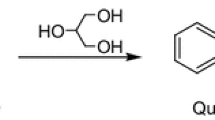Summary
Four new imide derivatives of 3-nitro-1,8-naphthalic acid have been synthesised. The compounds show strong cytostatic activity against both HeLa and KB cells and are moderately toxic towards both mice and rats (LD50 above 4 mg/kg IP). Two of the most active compounds, M-4212 and M-12210, prevented the development of mouse Ehrlich ascites and rat Yoshida carcinoma. All these drugs block cell growth by inhibiting the synthesis of both DNA and RNA. In particular, both M-4212 and M-12210 raise the melting point of double-stranded DNA.
Similar content being viewed by others
References
Braña MF, Castellano JM, Jiménez A, Llombart A Sn, Rabadan FP, Roldán M, Roldán C, Santos A, Vázquez D (1978) Synthesis, cytostatic activity, and mode of action of a new series of imide derivatives of 3-nitro-1,8-naphthalic acid. In: Proceedings of the Tenth International Congress of Chemotherapy, Zurich 1977, p 1216
Chandra P, Woltersdorf M (1974) Influence of tilorone and cogeners on the secondary structure and template activity of DNA. FEBS Lett 41:169–173
Dore JC, Sekera A, Redeuilh G, Viel C (1973) Antitumor chemotherapy and synthesis in the area of natural antitumor agents. IV. Replacement of the nitro group inactive β-nitrostyrenes by various electron-attracting substituents. Chim Ther 8:75–79
Geran RI, Greenberg NH, MacDonald MN, Schumacher AM, Abbot BJ (1972) Protocols for screening chemical agents and natural product against animal tumors and other biological systems. Cancer Chemother Rep [Part 3] 3:59–61
Hahn FE, Krey AK (1972) Interactions of alkaloids with DNA. In: Hahn, FE (ed) Progress in molecular and subcellular biology, Vol 2. Springer, Berlin Heidelberg New York, pp 134–151
Jiménez A, Santos A, Alonso A, Vázquez D (1976) Inhibitors of protein synthesis in eukaryotic cells. Comparative effects of some Amaryllidaceae alkaloids. Biochim Biophys Acta 425:342–348
Kupchan SM, Doskotch RV (1962) Tumor inhibitors. I. Aristolochic acid, the active principle of Aristolochia indica. J Med Pharm Chem 5:657–659
Mueckter H, Frankus E, More E (1969) Experimental therapeutic investigations with 1-morpholinomethyl-4-phtalimidopiperidine-2,6-dione on dimethylbenzanthracene-induced tumors of Sprague Dawley rats. Cancer Res 29:1212–1217
Roldán CM, Braña MF, Castellano JM (1973) Up procedimiento para la preparación industrial de naftalimidas sustituidas en el nitrógeno y en la posición tres y sus derivados. Spanish Patent no. 410.740
Vázquez D (1974) Inhibitors of protein synthesis. FEBS Lett [Suppl] 40:S63-S84
Author information
Authors and Affiliations
Rights and permissions
About this article
Cite this article
Braña, M.F., Castellano, J.M., Roldán, C.M. et al. Synthesis and mode(s) of action of a new series of imide derivatives of 3-nitro-1,8 naphthalic acid. Cancer Chemother. Pharmacol. 4, 61–66 (1980). https://doi.org/10.1007/BF00255461
Received:
Accepted:
Issue Date:
DOI: https://doi.org/10.1007/BF00255461




